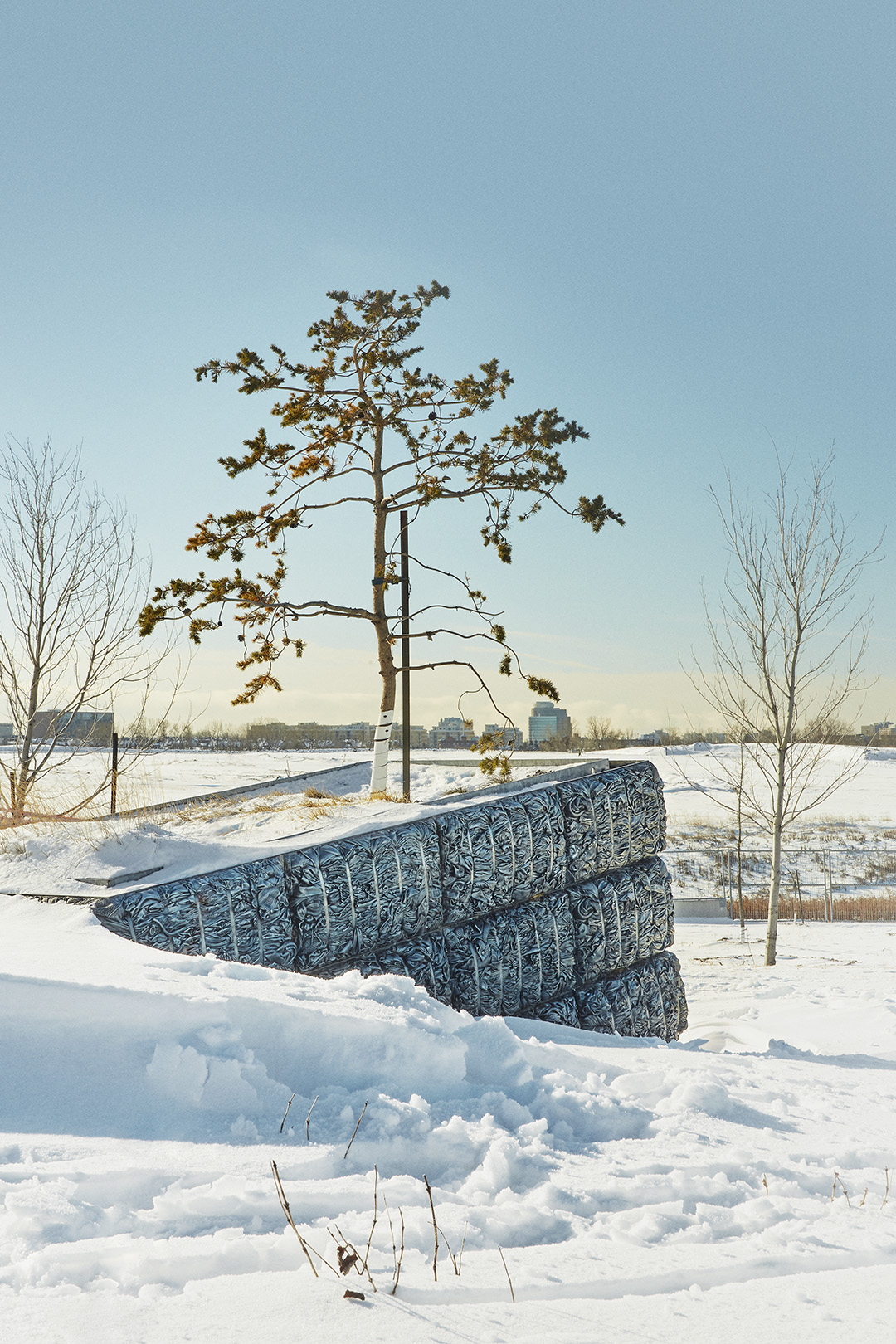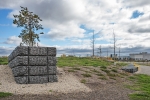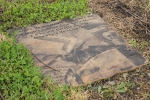Alain-Martin Richard
Anamnèse 1+1
2017
Presentation of the artwork
Anamnèse 1+1 is a permanent work integrated into the flat section of Frédéric-Back Park, in the Saint-Michel Environmental Complex. It is the result of intense research and cultural mediation undertaken by the artist with the citizens in the Saint-Michel–Parc-Extension district over almost two years. The two-part work is composed of a rectangular volume made of cast aluminum, the lateral walls of which have been molded from recovered bundles of fabric. From this open container emerges a tree as a symbol of renewal. These walls literally relate the ethnographic thread of the fabric of our lives. The other part of the artwork includes 30 partially buried calcareous stones sprinkled along the footpaths, a short distance from the central element. Words are engraved on these stones, along with reproductions of residents who took part in the artist’s intervention. Anamnèse 1+1 avoids nostalgia, as it revives the memories and honours the participation of those who are the life’s blood of this part of the city. It finds a balance between the living and the inert and transforms the wound in the land into a radiant flowering that points to the future. Associated events
Frédéric-Back Park, situated in the centre of the Saint-Michel Environmental Complex in the Villeray–Saint-Michel–Parc-Extension borough, is the result of the spectacular metamorphosis of a former quarry and landfill site into a vast green space. It is the most ambitious environmental rehabilitation project ever undertaken by the City. When complete, its total area of 192 hectares will rival that of Mount Royal Park
Alain-Martin Richard
Alain-Martin Richard is a performer, publisher, critic, essayist, and curator. In his multidisciplinary practice, he focuses on the questions of art in society and art as poetic action. He uses a “dialogue-action” strategy, in which each action is seen in phase with the place where it takes place and the people who live there. His projects are deployed on several levels of reality, as seen in L’Atopie textuelle est une cause qui se perd (2000); Le chemin pour Rosa (2006); Le bloc que j’habite (2014). He is an active member of the collective Les Causes perdues and of Folie/Culture.
Presentation of the artwork
Anamnèse 1+1 is a permanent work integrated into the flat section of Frédéric-Back Park, in the Saint-Michel Environmental Complex. It is the result of intense research and cultural mediation undertaken by the artist with the citizens in the Saint-Michel–Parc-Extension district over almost two years. The two-part work is composed of a rectangular volume made of cast aluminum, the lateral walls of which have been molded from recovered bundles of fabric. From this open container emerges a tree as a symbol of renewal. These walls literally relate the ethnographic thread of the fabric of our lives. The other part of the artwork includes 30 partially buried calcareous stones sprinkled along the footpaths, a short distance from the central element. Words are engraved on these stones, along with reproductions of residents who took part in the artist’s intervention. Anamnèse 1+1 avoids nostalgia, as it revives the memories and honours the participation of those who are the life’s blood of this part of the city. It finds a balance between the living and the inert and transforms the wound in the land into a radiant flowering that points to the future. Associated events
Frédéric-Back Park, situated in the centre of the Saint-Michel Environmental Complex in the Villeray–Saint-Michel–Parc-Extension borough, is the result of the spectacular metamorphosis of a former quarry and landfill site into a vast green space. It is the most ambitious environmental rehabilitation project ever undertaken by the City. When complete, its total area of 192 hectares will rival that of Mount Royal Park
Alain-Martin Richard
Alain-Martin Richard is a performer, publisher, critic, essayist, and curator. In his multidisciplinary practice, he focuses on the questions of art in society and art as poetic action. He uses a “dialogue-action” strategy, in which each action is seen in phase with the place where it takes place and the people who live there. His projects are deployed on several levels of reality, as seen in L’Atopie textuelle est une cause qui se perd (2000); Le chemin pour Rosa (2006); Le bloc que j’habite (2014). He is an active member of the collective Les Causes perdues and of Folie/Culture.






